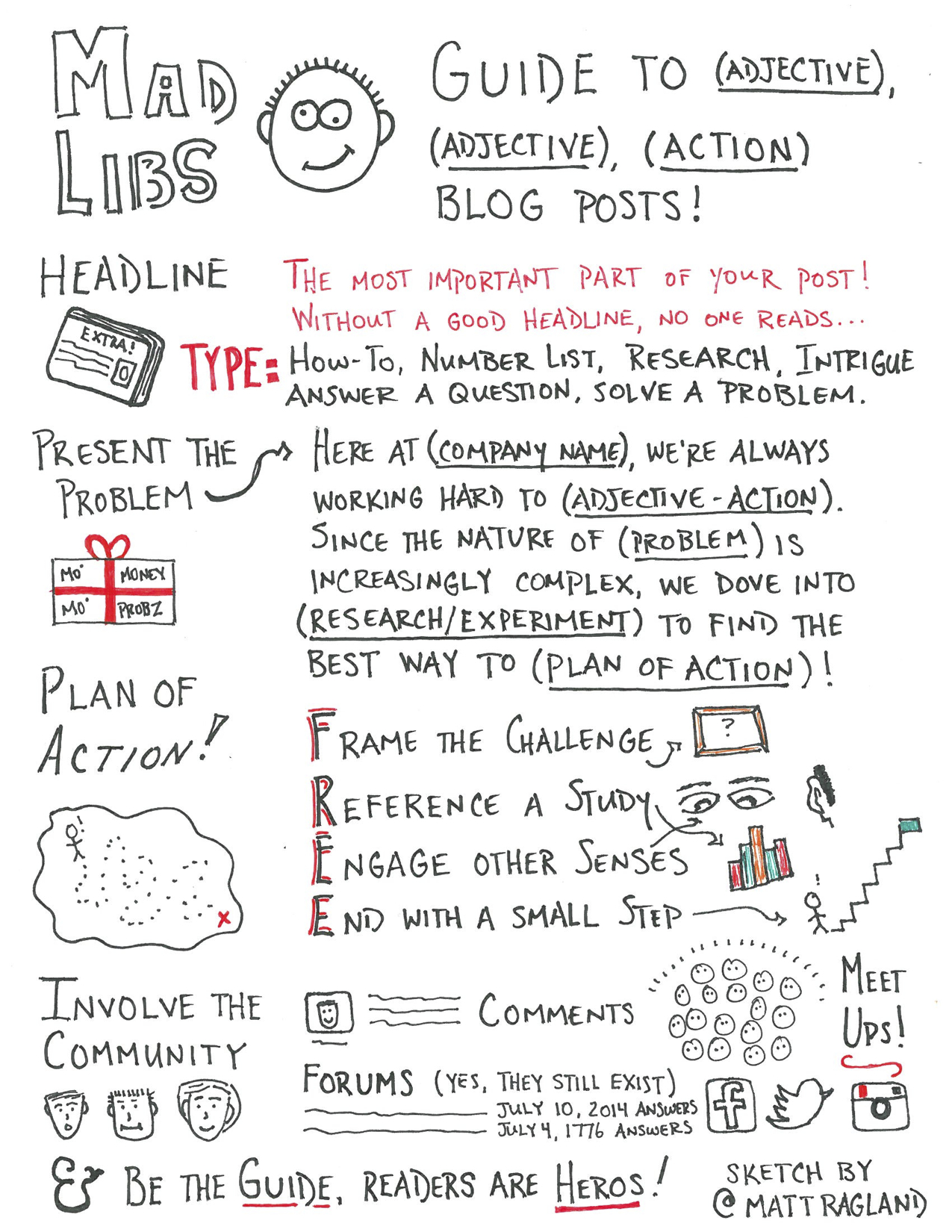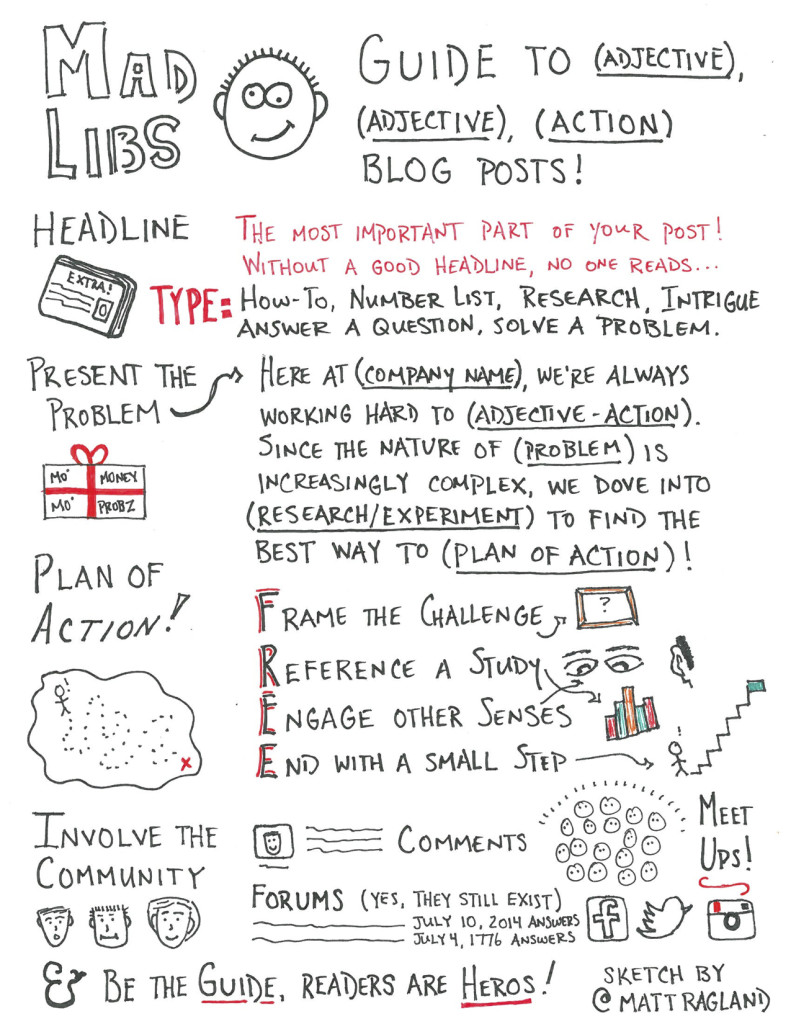Do you ever catch yourself perusing your Twitter, rss, or email feed, with a sneaky suspicion that all these posts sound eerily similar? The content usually differs (though not always), but the basic layout, flow, and hooks all fit into a neat framework?
That’s because they do.
Why this Framework Exists
Now, before you feel like you’ve been played, there’s a good reason for the structure and framework many of the best posts share. As content creators in an age of information parity, we strive to balance getting the point (or product) across, while benefiting the reader and helping the idea stick in your mind.
This framework is driven by a substantial amount of research and testing, so the baseline can be set for overall length, readability, media choices, and stickiness. Sometimes I’m reminded of Mad Libs, plugging in adjectives, nouns, actions, and studies to create a killer blog post. Many people may see this as a shortcut, but I don’t. I see it as a way to create order out of chaos.
HelpScout, Buffer, CopyBlogger, HubSpot all immediately jump to mind, and for good reason. They’ve mastered the art of content marketing as a tool to educate users and connect with customers. You don’t even really feel like a customer, but a part of the greater tribe, and happily refer your friends and clients to them.
In a connection economy, driven by stories and research studies, most customers will not tolerate being interrupted. But they will develop incredible brand loyalty to the companies that commit to helping them them solve problems and overcome challenges. Hopefully, this is the type of company you desire to be. Helpful, informative, and profitable.
Using the Guide Mindset
How can you do this with your company? Great question. I want to share the framework I’ve been using to write posts and case studies, and they’ve resulted in articles that have been shared thousands of times.
Before we begin, you have to place yourself in the mindset of a guide, not a hero. When people feel like they are a part of greater story, solving problems and overcoming challenges in their lives, they are the hero. You are the guide, and present a plan of action for the hero to follow.
Think like a guide, not a hero.
Step 1: The Headline
Types: How-To, Numbered List, Research Study, Intrigue (Answer a Question, Cite a Study, Solve a Problem)
Why this Matters
Headlines are the most important part of any article, because they must draw in the reader. Especially in the context of a startup company like Buffer or HelpScout, quality headlines can make or or break your content marketing goals. At the beginning, we haven’t built the readership of large sites or online magazines.
Whether the first glance is seen on social media, rss feeds, or emails, a good headline is the difference between your article and the next one. The types I’ve listed above help clarify the problem or challenge, and present a plan of action for moving forward.
Master Level Resources
- Copyblogger – Writing Magnetic Headlines
- Goins, Writer – 5 Tips to Writing Catchy Headlines
- Buffer A/B Testing Headlines
- The Upworthy 25 Headline Challenge
- Example: This Coach Improved Every Tiny Thing by 1% and Here’s What Happened
Step 2: Presenting the Problem or Challenge
Here at (company name), we’re always working hard to (adjective-action). Since the nature of (problem or challenge) is increasingly complex, we dove into (research, case study, experiments) so we could share the best way to (plan of action).
Why this Matters
Clarity is king. Attention spans continue to decrease while the amount of information increases, meaning if you haven’t made the challenge clear in the opening paragraph and headline, your readers are leaving. In order to clarify the challenge, you must be in tune with your readers, know the pains and problems they are experiencing, and be ready to offer a plan of action.
Master Level Resources
- Storyline – Leadership is Clarity
- NY Times – Is This Headline Clear?
- Copyblogger – How to Write with Clarity
- Both Sides of the Table – Identifying the Pain
Step 3: The Plan of Action – Using F.R.E.E. Structures
Breaking down a post to several small plans of action is helpful for readers. It helps contextualize the problem and make the solution attainable. Use sub-headlines to break up your sections and provide clear reference points for the plan of action.
I’ve come up with a structure that helps create helpful sections for readers, almost like creating several “mini-posts” within the larger article. Using this structure, the reader could leave the page at any time, and still have something helpful and actionable to move forward with. Here is the structure:
Frame the challenge in a smaller context
Reference or research study
Engage other senses through images
End by giving the reader a small step they can take today
Why this Matters
This step is where your skill as a guide really comes in to play. Remember this story is not about you, but the ways you can guide the reader towards a proper plan of action. The F.R.E.E. structure simply helps organize the sub-section into memorable and digestible format that sticks with the reader, regardless of where they stop reading. You can repeat this structure for each section until you’re ready to tie everything together.
Master Level Resources
- The Science of Starting Small
- Buffer – 53 Free image Resources
- Kissmetrics – The Shocking Truth about how Web Graphics Affect conversions
- HelpScout – The Psychology of Color in Marketing and Branding
Step 4: Involve the Community
After you’ve presented the problem and given a clear plan of action, the next step is up to the reader. We’re not in control of their lives and cannot take action for them! However, there is a way we can help each other stay accountable and move forward, and it’s deeply ingrained in our anthropology. Community.
Why this Matters
As humans, we need to be supported by each other. We were made for connection and support, so it’s vital we have the structure in place to encourage people to connect! This could be through comments, forums, specific hashtags, Facebook groups, or local meet ups.
HelpScout does this in a subtle yet important box at the end of their posts, asking the readers to respond to just one question. Be very clear with the reader in ways they can connect with each other and share their struggles and successes in facing the challenge.
Master Level Resources
- Mashable – 10 Tips for Building an Online Communtiy around your Startup
- Social Media Examiner – 6 Tips for Starting an Online Community
- Inc – The Barn Raising Strategy
- MIT – Building Strong Brands through Online Communities (from 2000!)
This plug-and-publish method isn’t permission to avoid the hard work of research, formatting, and great writing. What it does help with is creating order and stickiness out of the chaos inherent in content. To help illustrate the ideas even better, here’s a handy sketch-o-graphic you can download to help remember!
Your Turn
As a content creator, what do you focus on the most? As a reader, what helps you digest and retain information best?
Thanks for reading, and I’ll see you in the comments!


Leave a Reply